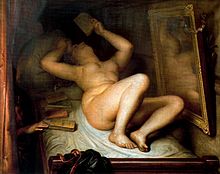
Impressionism was a 19th-century art movement characterized by relatively small, thin, yet visible brush strokes, open composition, emphasis on accurate depiction of light in its changing qualities, ordinary subject matter, unusual visual angles, and inclusion of movement as a crucial element of human perception and experience. Impressionism originated with a group of Paris-based artists whose independent exhibitions brought them to prominence during the 1870s and 1880s.

Mary Stevenson Cassatt was an American painter and printmaker. She was born in Allegheny, Pennsylvania, but lived much of her adult life in France, where she befriended Edgar Degas and exhibited with the Impressionists. Cassatt often created images of the social and private lives of women, with particular emphasis on the intimate bonds between mothers and children.

Olympia is a painting by Édouard Manet, first exhibited at the 1865 Paris Salon, which shows a nude woman ("Olympia") lying on a bed being brought flowers by a servant. Olympia was modelled by Victorine Meurent and Olympia's servant by the art model Laure. Olympia's confrontational gaze caused shock and astonishment when the painting was first exhibited because a number of details in the picture identified her as a prostitute. The French government acquired the painting in 1890 after a public subscription organized by Claude Monet. The painting is on display at the Musée d'Orsay, Paris.

Lesbian erotica deals with depictions in the visual arts of lesbianism, which is the expression of female-on-female sexuality. Lesbianism has been a theme in erotic art since at least the time of ancient Rome, and many regard depictions of lesbianism to be erotic.

The Milkmaid, sometimes called The Kitchen Maid, is an oil-on-canvas painting of a "milkmaid", in fact, a domestic kitchen maid, by the Dutch artist Johannes Vermeer. It is now in the Rijksmuseum in Amsterdam, the Netherlands, which regards it as "unquestionably one of the museum's finest attractions".

Qajar art refers to the art, architecture, and art-forms of the Qajar dynasty of the late Persian Empire, which lasted from 1781 to 1925 in Iran (Persia).

Feminist art is a category of art associated with the late 1960s and 1970s feminist movement. Feminist art highlights the societal and political differences women experience in their lives. The hopeful gain from this form of art is to bring a positive and understanding change to the world, in hope to lead to equality or liberation. Media used range from traditional art forms such as painting to more unorthodox methods such as performance art, conceptual art, body art, craftivism, video, film, and fiber art. Feminist art has served as an innovative driving force towards expanding the definition of art through the incorporation of new media and a new perspective.
Émilie Charmy was an artist in France's early avant-garde. She worked closely with Fauve artists like Henri Matisse, and was active in exhibiting her artworks in Paris, particularly with Berthe Weill.

The Child's Bath is an 1893 oil painting by American artist Mary Cassatt. The painting continues her interest in depicting bathing and motherhood, but it is distinct in its angle of vision. Both the subject matter and the overhead perspective were inspired by Japanese Woodcut prints and Edgar Degas.
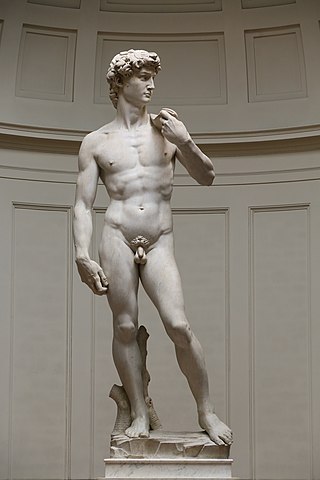
The nude, as a form of visual art that focuses on the unclothed human figure, is an enduring tradition in Western art. It was a preoccupation of Ancient Greek art, and after a semi-dormant period in the Middle Ages returned to a central position with the Renaissance. Unclothed figures often also play a part in other types of art, such as history painting, including allegorical and religious art, portraiture, or the decorative arts. From prehistory to the earliest civilizations, nude female figures are generally understood to be symbols of fertility or well-being.
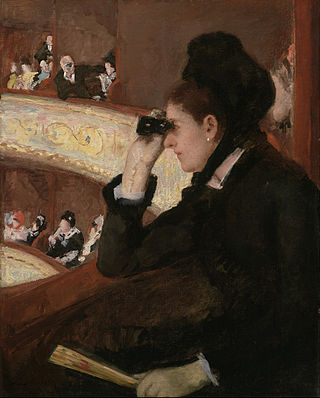
In The Loge, also known as At The Opera, is an 1878 Impressionist painting by the American artist Mary Cassatt. The oil-on-canvas painting is currently in the Museum of Fine Arts, Boston, which also holds a preliminary drawing for the work. The painting displays a bourgeois woman at the opera house looking through her opera glasses, while a man in the background looks at her. The woman's costume and fan make clear her upper class status. Art historians see the painting as commentary on the role of gender, looking, and power in the social spaces of the nineteenth century.
Feminist art criticism emerged in the 1970s from the wider feminist movement as the critical examination of both visual representations of women in art and art produced by women. It continues to be a major field of art criticism.

After the Bath, Woman Drying Herself is a pastel drawing by Edgar Degas, made between 1890 and 1895. Since 1959, it has been in the collection of the National Gallery, London. This work is one in a series of pastels and oils that Degas created depicting female nudes. Originally, Degas exhibited his works at Impressionist exhibitions in Paris, where he gained a loyal following.

In feminist theory, the male gaze is the act of depicting women and the world in the visual arts and in literature from a masculine, heterosexual perspective that presents and represents women as sexual objects for the pleasure of the heterosexual male viewer. In the visual and aesthetic presentations of narrative cinema, the male gaze has three perspectives: (i) that of the man behind the camera, (ii) that of the male characters within the film's cinematic representations; and (iii) that of the spectator gazing at the image.
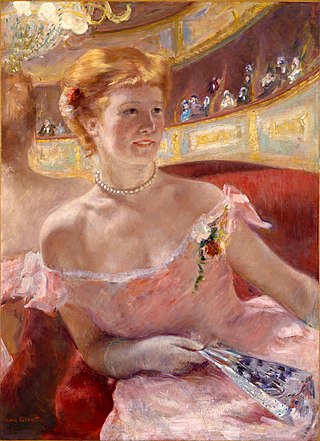
Woman with a Pearl Necklace in a Loge is an 1879 painting by American artist Mary Cassatt. The Philadelphia Museum of Art acquired the painting in 1978 from the bequest of Charlotte Dorrance Wright. The style in which it was painted and the depiction of shifting light and color was influenced by Impressionism. This painting shows a view of the modern woman and is similar in style to Degas.
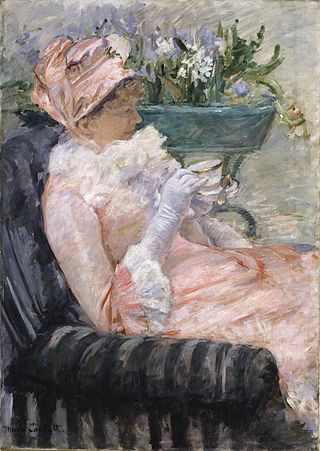
The American artist Mary Cassatt painted The Cup of Tea in Paris ca. 1879–81. The painting depicts Mary’s sister Lydia Cassatt in a typical, upper class-Parisian ritual of afternoon tea. Scholars have observed that Cassatt’s choice to employ vivid colors, loose brushstrokes, and unique perspective to portray the scene makes it a quintessentially Impressionist painting.

Woman with a Sunflower is a 1905 oil painting by the American artist Mary Cassatt. It has been in the collection of the National Gallery of Art in Washington, DC since 1963.
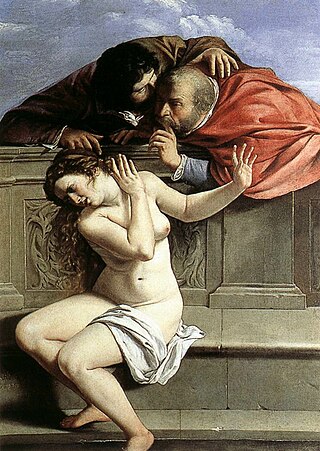
Susanna and the Elders is an Old Testament story of a woman falsely accused of adultery after two men who, after discovering one another in the act of spying on her while she bathes, conspire to blackmail her for sex. Depictions of the story date back to the 9th century, but were infrequent until the Renaissance.

The Tea, also referred to as Five O’Clock Tea, is an oil-on-canvas painting of two women having tea by the American Impressionist painter Mary Cassatt. The role of gender in the painting has been the subject of differing interpretations among art historians. Griselda Pollock describes the confined interior as an evocation of the spatial and social constraints placed on women at the time. Norma Broude asks whether the work might contain "possibilities for empowerment," showing the agency that women exercised through sociability. And John Loughery argues that the intention behind Cassatt's work might always remain a mystery.

A Woman and a Girl Driving is an oil on canvas painting by American Impressionist Mary Cassatt, created in 1881. It depicts the artist's sister Lydia alongside Odile Fèvre, the niece of Edgar Degas, in a carriage traveling through the Bois de Boulogne. Scholars have seen the painting as a representation of growing female autonomy in the Parisian public sphere, where driving one's own carriage signified independence. The painting is held at the Philadelphia Museum of Art.

